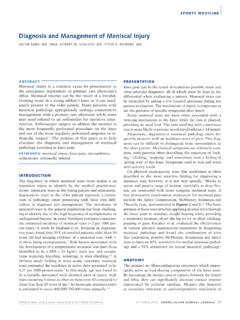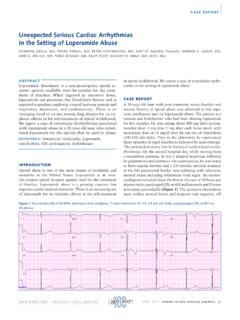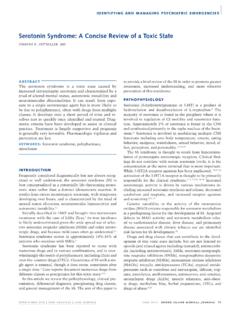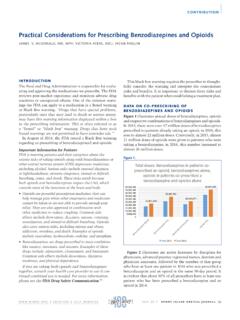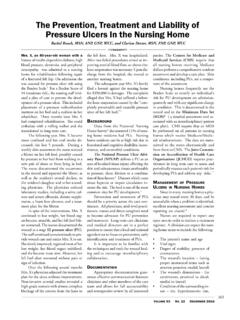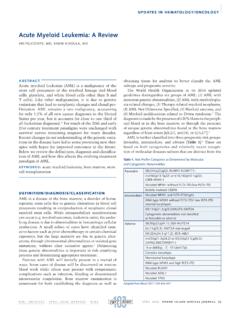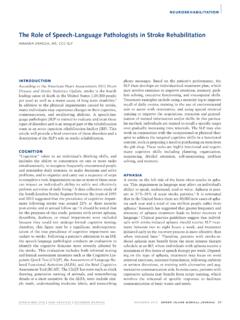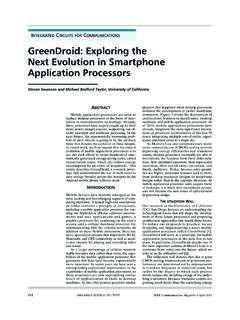Transcription of Leadless Cardiac Pacemakers: The Next Evolution in ...
1 CONTRIBUTIONL eadless Cardiac Pacemakers: The next Evolution in pacemaker TechnologyBRIAN D. MCCAULEY, MD, MPH; ANTONY F. CHU, MDABSTRACT Implantable pacemakers stand as a mainstay in our therapeutic arsenal, affording those suffer-ing from advanced Cardiac conduction system disease both an improved quality of life and re-duced mortality. Annually, over 225,000 new pacemakers are implanted in the United States for bradyarrhythmias and heart block. The first implantable transvenous pacemakers appeared in 1965; they were bulky devices, hobbled by a short battery life, and a single pacing mode. Modern transvenous pacemakers have evolved considerably with significant improvements in battery life, pacing options, and lead tech-nology but are still subject to a spectrum of complications stemming from either the sub-cutaneous pocket or the leads, including: hematoma, infection, wound dehiscence, pneumothorax, Cardiac tamponade, lead dislodgment, upper extremity deep vein thrombosis, lead failure, venous obstruc-tion, tricuspid valve insufficiency, and endocarditis.
2 Single-chamber right ventricular (RV) Leadless Cardiac pacemakers, a concept from the past, has been revital-ized to address these complica-tions. Improvements in battery life, device miniaturization, catheter-based delivery tools, and advanced programming have made Leadless Cardiac pacemakers a viable option. In this review, we will discuss single-component Leadless car-diac pacemaker technology , provide an overview of the two approved devices, and dis-cuss their benefits as well as their : arrhythmias, Cardiac ; Cardiac pacing, artificial; Leadless pacing; pacemaker , artificialINTRODUCTIONI mplantable pacemakers stand as a mainstay in our therapeutic arsenal, affording those suffering from advanced Cardiac conduction system dis-ease both an improved quality of life and reduced mortality (1-4). Annually, over 225,000 new pace-makers are implanted in the United States for bradyarrhythmias and heart block (5).
3 The first implantable transvenous pacemakers appeared in 1965. They were bulky devices, hobbled by a short battery life, and a single pacing mode. Mod-ern transvenous pacemakers have evolved consid-erably with significant improvements in battery life, pacing options, and lead technology , but are still inserted similar to the original devices from the 1960s; with a pectoral-placed pulse generator connected to intracardiac transvenous pacing leads (6). Accordingly, while modern pacemak-ers are significantly more elegant devices, unfortunately they share many complications with their predecessors. In the short term, the subcutaneous pocket, in which the genera-tor lies, is subject to hematoma, infection, and wound dehiscence. Intervention for cutaneous poc-ket complications increases the infection risk 15-fold (7-9).
4 In addition to the risk posed by the subcutaneous pocket, transve-nous leads have both short- and long-term sequelae. In the acute setting, the insertion of transve-nous leads can lead to pneumo-thorax, Cardiac tamponade, lead dislodgment, or upper extremity deep vein thrombosis and compli-cation rates may be as high as 8% to 12% (10,11). Long-term com- plications from transvenous leads include lead failure, venous ob- struction, tricuspid valve insuffi-ciency, and endocarditis (11,12). In the simplest of the modern pacing configurations, a subcuta- Medtronic s Leadless Micra Transcatheter Pacing System (TPS). | ARCHIVES | NOVEMBER WEBPAGE31 NOVEMBER 2017 RHODE ISLAND MEDICAL JOURNAL CONTRIBUTION neous generator with a single-chamber lead, more than 1 in every 40 implants will require surgical intervention within 3 months of implantation; half of which are attributable to lead issues (12-14).
5 Additionally, over the life of the device, lead failures are associated with significant morbidity (11). In the 1970s, physicians, in concert with device engineers, developed the idea of a Leadless pacemaker . They success-fully implanted a self-contained RV Cardiac pacemaker in a canine model with induced complete heart block, achieving 66 days of captured pacing. However given the technologic limitations of battery life inherent to the 1970s, the idea was shelved (15). Recently, advances in battery life, device miniaturization, improved catheter-based delivery tools, and advanced programming to optimize power consump-tion have assisted in making Leadless Cardiac pacemakers a viable option (16-19). In this review, we will discuss sin-gle-component Leadless Cardiac pacemaker technology , pro-vide an overview of the two main devices, and consider their benefits and Leadless Cardiac PACEMAKERSC urrently, there are two single-component Leadless Cardiac pacemakers: 1) the Micra Transcatheter Pacing System (TPS; Medtronic) which received FDA approval in April 2016 and 2) the Nanostim Leadless Cardiac pacemaker (LCP; St.
6 Jude Medical) which is currently waiting FDA approval. Both devices are fully self-contained units, transcutane-ously deployed via the femoral approach and capable of sin-gle-chamber RV pacing, sensing, and rate responsiveness. The Nanostim LCP is longer than the Micra TPS (42 mm versus mm), but they displace similar volumes ( and mL). While the implantation procedure for both devices is similar, the Micra TPS requires a 27 French delivery sheath, while the Nanostim LCP uses a smaller 21 French delivery sheath. Once the device is advanced to the RV, site selection is accomplished via contrast-enhanced visualization. The pacemaker is then deployed using 4 self-expanding nitinol tines (Micra TPS) or an active screw-in helix with 3 angled nitinol tines perpendicular to the helix (Nanostim LCP). Fol-lowing anchoring of the pacemaker , electrical parameters are assessed, internal fixation is tested using a gentle tug test, and the device is then deployed from the sheath.
7 Retrievability is an important consideration for Leadless Cardiac pacemakers. The Nanostim LCP has a dedicated steerable retrieval system. If a retrieval is warranted, the distal cap of the pacemaker is captured by the snare of the retrieval catheter, then rotated counter-clockwise to release the device from the myocardium. The Micra TPS does not have a dedicated retrieval system, but in several cases has been retrieved by employing a conventional goose-neck snare through a guiding sheath. Neither system has demon-strated long-term retrievability in humans, but has been demonstrated in animal models. CLINICAL DATA: SAFETY AND PERFORMANCEThe data regarding the safety and efficacy of Leadless pace-makers was spearheaded by the Leadless Trial. Using the Nanostim LCP device, 33 patients (mean age 77 years, 67% male) at 3 centers were enrolled over a four-month period in 2012-2013.
8 The Nanostim LCP was successfully implanted in 32/33 (97%) patients. Overall, freedom from complica-tions was 94% (31/33) at 90-day follow-up. There was one major complication: a 70-year-old male experienced Cardiac tamponade with hemodynamic collapse during Nanostim LCP implantation, requiring emergent Cardiac surgery, and died of an ischemic stroke due to a sub-therapeutic INR 3 weeks later (17). A second clinical study, for safety and efficacy of the Nanostim LCP system, Leadless III, was prospectively performed in 56 centers in 3 countries (Australia, Canada, and USA) and enrolled 526 patients (mean age 75 years, 62% male), 300 with a minimum follow-up of 6 months. The Nanostim LCP was successfully implanted in 504/526 ( ), mean procedure time was minutes, and 70% of deployed devices did not require repositioning.
9 Device-related serious adverse events occurred in 34 ( ) of patients and included pericardial effusion , vascular complication , dislodgment (4 to pulmonary vein, 2 to femoral vein), and device retrieval due to elevated pacing thresholds (18). Of note, St. Jude, manufacturer of the Nanostim LCP, issued a battery advisory due to a mal- function in 7/1423 ( ) devices, occurring between months 29 37 following implantation. The malfunction caused abrupt battery depletion, eliciting a loss of pacing and failed communication. The Micra TPS Trial was a global, multicenter prospec-tive study aimed at device safety and efficacy. The study enrolled 725 patients (mean age 75, male) who met guidelines for RV pacing. The Micra TPS was successfully implanted in 719/725 ( ), with a mean procedure dura-tion of minutes.
10 Device-related serious adverse events occurred in 25 ( ) patients and included Cardiac perforation , vascular complications in , venous thromboembolism in , and increasing pacing thresh-olds in of patients. No device dislodgment or emboli-zation were observed. There was one major complication: a 77-year-old woman with end-stage renal failure, who under-went concomitant atrioventricular nodal ablation during the Micra TPS implant, died. Her death was likely attributable to a metabolic acidosis from her underlying renal failure and a prolonged procedure time (18).POTENTIAL BENEFITS/LIMITATION TO Leadless Cardiac PACINGThe most obvious benefit of Leadless pacing technology stems from mitigation of the short- and long-term risks asso-ciated with the traditional subcutaneous pocket with trans-venous leads. The Nanostim LCP has a battery life that is | ARCHIVES | NOVEMBER WEBPAGE32 NOVEMBER 2017 RHODE ISLAND MEDICAL JOURNAL comparable to that of standard, single-chamber transvenous pacemakers.
